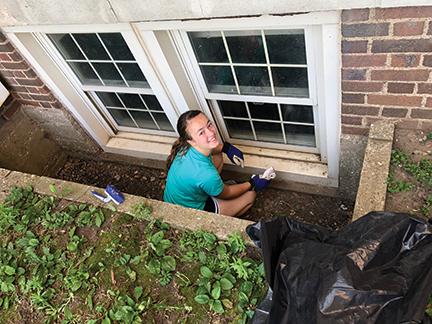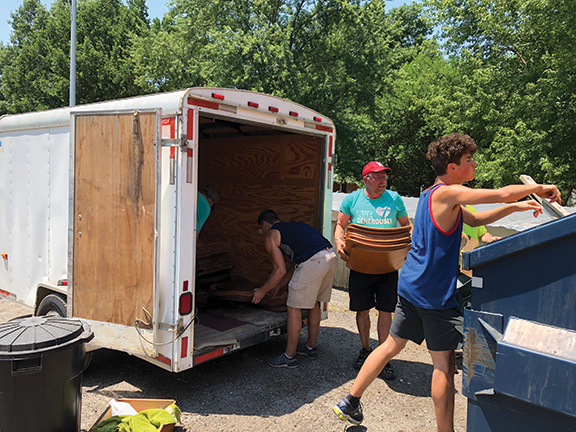
The Missouri District has 114 educational ministries, which serve communities in cities, the countryside and everywhere in between. Schools serving rural and small town communities, often have a unique experience, but one that brings significant benefits to students and their families. Here’s how our educational ministries are serving two areas: Frohna and Concordia.
Frohna
When students walk into class at United in Christ Lutheran School, the teachers often know them from church, the Frohna community, and in some cases, having taught their parents. Nestled approximately 30 minutes from both Perryville and Cape Girardeau, United in Christ serves many families of generational students. Ms. Honoree, the principal, says a feeling of being a family is one of the things we do best.
The Lutheran faith has been historically well represented in this part of Missouri, and as a result, United in Christ serves almost all families from the association of three congregations that support it, support which includes covering tuition of members’ children. As a result, approximately 90 percent of their students attend a Lutheran church with their families. Ms. Honoree says this means they can take an advanced approach to teach the faith.
They have a 15-minute chapel service every day, with a bible verse and a hymn verse. All the kids are well educated not only about the words of the ten commandments, but the meaning behind them as well. She quips, “If a kid comes into my office for discipline, I can ask them ‘Which commandment [are we here about?]’”
In addition to the local Lutheran heritage, many of the United in Christ students share farming and hunting. Many parents who work jobs in Perryville and Cape Girardeau also farm part-time, either on plots of land or through seed companies. This can make it hard for parents to attend classroom events or chaperone field trips. To help them out, the staff goes to great lengths to plan all activities like Grandparents’ Day and big field trips as far out as possible, so parents who want to take off work can. Even with these efforts, she notes that it’s often hard for parents to be as involved as they’d like to. That’s why the school opens its doors at 6:30 a.m., to help some of the parents manage their commutes to work in nearby cities.
Hunting is a big part of community life, and after families nab a big buck or turkey, they often drive through the community and show it to their friends and relatives. Sometimes, a close relative might show up at school with a turkey in the truck and ask, “Can Johnny come take a look at my turkey?” And the school recognizes the value of this experience and makes it work. Sometimes, a teacher might greet students by asking, “Did you get a deer this weekend?” if she knows they were out in the woods that weekend.
With 80 students and a staff of seven full-time and five part-time people, United in Christ utilizes dual grade classrooms from first grade on (pre-K and kindergarten classrooms are separated out). While many small schools take this approach due to their size, Ms. Honoree wrote her research paper for her master’s degree on mixing ages in classrooms. The research supports many benefits to this approach.
In a dual-grade classroom the older kids hear the material being taught to the younger kids and they get a review. Similarly, the younger kids get a sense of what’s they’ll learn later on. Ms. Honoree notes that their kids tend to do very well on standardized tests, and they do particularly well on tasks that involve critical thinking and independence, traits that are not easy to teach. Because of the nature of their classroom experience, the kids learn these skills organically.
Another advantage comes in reading groups. A lower reading group in a second grade class might overlap with the top reading group of a first grade class. With a dual grade classroom, the teacher can place students in groups more closely aligned to ability. The biggest downside is the effort and classroom management required by the teachers, though Ms. Honoree notes that the teachers at United in Christ have embraced this approach.
Concordia
In a town of approximately 3,000 people, the influx of students from everywhere in the United States and across the world make a big difference to the community. Approximately a third of the students at Saint Paul High School are international, another third are from across the country and the remaining third are local.

The Executive Director, Rev. Paul Mehl, encourages all students, even the day students, to spend at least one semester in the dormitory. The experience of navigating a shared space with other people build communication and conflict resolution skills, as well as preparing the students for college.
For the international students, climate and culture are a big part of the adjustments they make living on campus. For students from Norway for example, the landscape is much flatter than the mountainous scenery they’re accustomed to. Plus, it’s a new lifestyle for some of these students to be somewhere people go to church not every week, but every single day.

Church work is a significant focus at Saint Paul. Of the enrolled students, approximately 25 percent of them will go onto professional church work for their career. In light of this statistic, the service opportunities present for students makes a lot of sense. The football team regularly volunteers at a local nursing home, and many students work with Orphan Grain Train, a program that helps deliver material resources to people in need. Rev. Mehl says, “If you’re not interested in ministry at [this school], you’re a bit of a weirdo.”
At the local elementary school, St. Paul, Nathanael Poppe sees an organic connection between the community and his students. As with many other rural and small town educational ministries, he sees families go to great lengths to ensure their children and grandchildren receive a Lutheran education. This means they have a lot of highly engaged kids, who attend the congregation’s youth group services. They’re very good about bringing their friends from school who don’t come from a religious family. As a result, many students at St. Paul attend youth events, even if their families are not members of the congregation.
